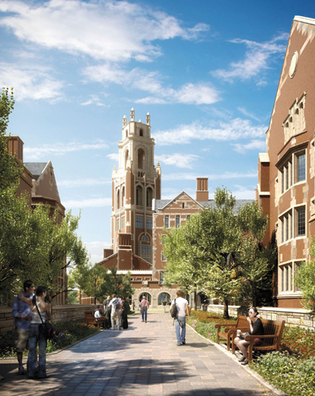
DBOX for Robert A. M. Stern Architects, LLP
An artist’s rendering of the future Prospect Walk, a pedestrian path between the new colleges, shows the 190-foot tower of North College. (As the two colleges have yet to be named, they’re being called North College and South College for now.)
View full image
What will the new colleges be called?
The Yale Corporation, the university’s board of trustees, has not made that decision yet. They have said, though, that the colleges will not be named for donors to the project.
Where will the new colleges be?
Near Science Hill, on a triangle of land west of Prospect Street between the Grove Street Cemetery and Ingalls Rink.
How will Yale accommodate the increased number of students?
The university says that a 7.5 percent increase in the number of tenured faculty since the colleges were first proposed will help meet the increased demand. Also, a faculty committee has recommended adding new non-tenure-track instructors for certain “gateway courses,” particularly in English, foreign language, science, and math.
Will they house freshmen?
Yes, like Silliman and Timothy Dwight Colleges, the new ones will house freshmen.
How much will they alleviate annexing in the existing colleges?
In addition to allowing Yale to admit about 200 more students each year, the new colleges will take about 50 students a year who would have been assigned to one of the other 12 colleges, allowing a reduction in annexing and, it is hoped, off-campus living.
How many students will they house?
Between them, the colleges will house 904 students, making them slightly larger than Silliman College, which houses 392.
How much will the colleges cost? And how are they being funded?
$500 million, all of it given by donors—most notably a $250 million gift from Charles Johnson ’54.
Will the new colleges be environmentally sustainable?
The colleges have been designed with the goal of achieving LEED Gold certification, the second-highest ranking from the US Green Building Council.
Will there be gargoyles?
Perhaps! There will be a program of sculptural ornament in the new colleges.
 loading
loading
7 comments
-

David E. McNamara, MD '78, 7:06pm March 10 2015 |  Flag as inappropriate
Flag as inappropriate
-

Hank Powell '71, 7:46pm March 11 2015 |  Flag as inappropriate
Flag as inappropriate
-

Mark Branch, 8:54am March 12 2015 |  Flag as inappropriate
Flag as inappropriate
-

Marc E. Nicholson, '71, 5:53pm March 12 2015 |  Flag as inappropriate
Flag as inappropriate
-

George Lloyd MFA '69 , 3:34pm March 13 2015 |  Flag as inappropriate
Flag as inappropriate
-

Thomas Davies, 3:46pm March 24 2015 |  Flag as inappropriate
Flag as inappropriate
-

Steven S. Hall, 3:44am March 29 2015 |  Flag as inappropriate
Flag as inappropriate
The comment period has expired.Credit must also be given to Beatrix Farrand Jones who was responsible for the landscape architecture of the residential colleges as well as specimen plantings throughout the campus. The more I read about her the more I am convinced that she had a strong influence over Rogers in designing the small courtyards, "moats", and other ideas that make the campus so pleasant. She was clearly way ahead of her time in terms of landscape architecture and green space design- although she rarely gets credit. She was involved with Yale for over 40 years and her influence has been immense. I hope her thinking is incorporated into the new residential colleges. I, for one, would be happy if one of the colleges was named for her. Unlikely as that may be she has had an enormous influence on how we experience the campus today.
Having spent a significant time atop Harkness Tower my sophmore year, I'm curious how the height of the new tower will compare with others on campus?
Hank Powell: The tallest tower will be 190 feet, 26 feet shorter than Harkness Tower. But the elevation is slightly higher on the site of the new collleges, so they'll appear comparable in height.
As a Beatrix Farrand "fan" (I'm on the Board of a DC Conservancy seeking to restore Dumbarton Oaks Park, which once was part of the Dumbarton Oaks Estate--Farrand's greatest creation), I fully agree with David McNamara's comments above that Farrand's landscape design principles should help guide the plantings of the new residential colleges. As I recall, Yale already has sought in part to restore her legacy there, in particular in the Harkness Quadrangle, and Princeton--where she landscaped the entire historic core campus--has for some years been embarked upon a long-term effort to restore her "green" legacy there....a tribute to the timelessness of good design and good taste.
What have we here , ARCHITECTURE or TAXIDERMY ? What a difference 5 decades have made . Frankly , this dreadful DISNEYLAND assemblage ,when compared to th noble example of MORSE and STILES colleges , built a half century ago by SAARINEN , makes me despair not only for th future of ARCHITECTURE but for YALE as well .
Architectural style = mindset of the school's leadership. Clearly they are more enamored with Yale's past than with the potential of any future. But the real loss is for the present, which is deemed unworthy of expression.
To the detractors of Yale Gothic I would say:
I had the good fortune to have won the Yale lottery to be assigned to Saybrook for four joyous years. While Morse, Stiles, Silliman and the colonials are all excellent in their own way, Saybrook gave me a comfort level in all seasons that I know could not have been achieved in any other setting. So hats off to the new colleges being Gothic.